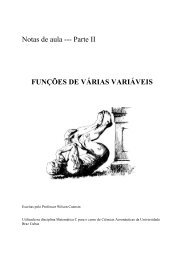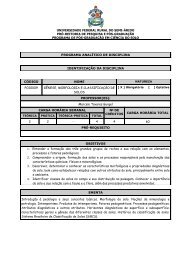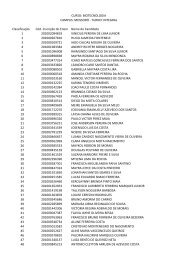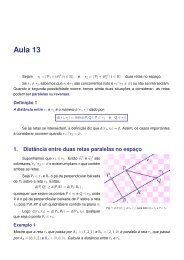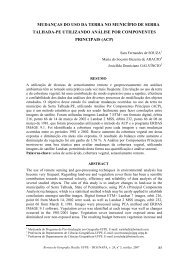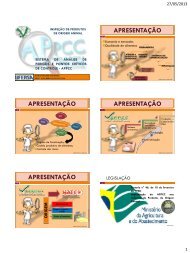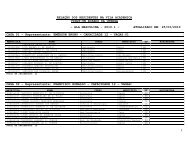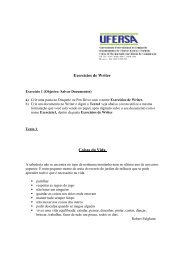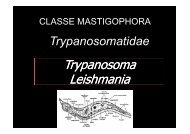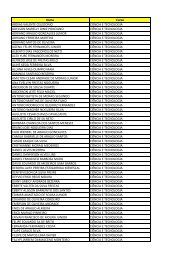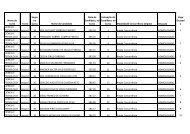Injectable Anesthesia and Analgesia of Birds by J. Paul ... - Ufersa
Injectable Anesthesia and Analgesia of Birds by J. Paul ... - Ufersa
Injectable Anesthesia and Analgesia of Birds by J. Paul ... - Ufersa
You also want an ePaper? Increase the reach of your titles
YUMPU automatically turns print PDFs into web optimized ePapers that Google loves.
Drug Dosage (Dose), Route Species / Remarks Reference<br />
Ketamine (K) /<br />
Medetomidine<br />
(Me) /<br />
Midazolam (Mi)<br />
(K) 7.3 - 11.2 mg/kg (10<br />
mg dose) / (Me) 36.5 - 56.2<br />
mg/kg (50mg dose) / (Mi)<br />
1.46 - 2.25 mg/kg (2 mg<br />
dose), IV<br />
Mallard ducks: 20 min duration; transient hypertension,<br />
bradycardia, <strong>and</strong> apnea; decreased respiratory rate after<br />
induction; resuscitation <strong>of</strong>ten required; survival risk;<br />
reversal with atipamezole, 0.25 mg, <strong>and</strong> flumazenil, 0.025<br />
mg, IV<br />
Machin<br />
[21]<br />
Ketamine (K) /<br />
Midazolam (M)<br />
(K) 10 - 25 mg/kg / (M)<br />
0.5 - 1.0 mg/kg, IM<br />
Pet <strong>Birds</strong>: (M) is short-acting & contraindicated when<br />
severe hepatic disease is present.<br />
Wheler<br />
[59]<br />
Ketamine (K) /<br />
Prop<strong>of</strong>ol (P)<br />
(K) 20 mg/kg, IM / (P)<br />
4.1 - 8.6 mg/kg (to effect),<br />
IV<br />
Pigeons (Columbia livia): ketamine followed <strong>by</strong> repeated<br />
doses <strong>of</strong> prop<strong>of</strong>ol provided ~ 3.5 min loss <strong>of</strong> muscle tone<br />
<strong>and</strong> pedal reflexes for each dose <strong>of</strong> prop<strong>of</strong>ol. Increased<br />
heart rate <strong>and</strong> decreased respiration within first minute<br />
after prop<strong>of</strong>ol administration. Apnea occurred after 62% <strong>of</strong><br />
the prop<strong>of</strong>ol incremental doses. Assisted ventilation was<br />
necessary to revive the bird if the apnea was prolonged.<br />
Budgerigars (Melopsittacus undulatus): no response to toe<br />
pinch within 5 min; anesthesia was effective for 45 + min<br />
2/14 birds died; one at 44 min <strong>and</strong> the other at 220 min<br />
after ketamine/xylazine administration. Reversal with<br />
yohimbine.<br />
Fitzgerald<br />
& Cooper<br />
[25]<br />
Ketamine (K) /<br />
Xylazine (X)<br />
(K) 40 mg/kg / (X) 10<br />
mg/kg, IM<br />
Heaton<br />
<strong>and</strong><br />
Brauth<br />
[16]<br />
(K) 50 mg/kg / (X) 4<br />
mg/kg, IM<br />
Goshawks (Accipiter gentilis): lethal dose!<br />
Lumeij<br />
[20]<br />
(K) 15 mg/kg / (X) 0.15<br />
mg/kg, IM<br />
Great Horned Owl (Bubo virginianus): immobilization<br />
noted within five min; transient apnea during initial 5 min;<br />
normal ventilation returned after 10 min Advise caution in<br />
using repeated doses due to an observed deterioration in<br />
cardiopulmonary stability. Supplemental oxygen improved<br />
cardiopulmonary performance.<br />
Raffe, et<br />
al. [19]<br />
(K) 50 mg/kg / (X) 4<br />
mg/kg, IM<br />
Pigeons: no satisfactory induction <strong>of</strong> anesthesia was<br />
observed at this dosage.<br />
Lumeij<br />
[20]<br />
(K) 4.4 mg/kg / (X) 2.2<br />
mg/kg, IV<br />
Red-tailed hawks (Buteo jamaicensis): adequate anesthesia<br />
for ~ 15 min <strong>of</strong> diagnostic or surgical procedures;<br />
significant respiratory <strong>and</strong> cardiovascular depression;<br />
reversal with yohimbine, 0.10 mg/kg, IV<br />
Degernes<br />
[14]<br />
(K) 5.0 mg/kg / (X) 1.0<br />
mg/kg, IV<br />
Ostrich (Struthio camelus) chicks (9 - 10 weeks): rapid<br />
induction; corneal reflexes remained present while pedal<br />
reflexes were lost in 3 <strong>of</strong> 4 birds for 2 - 7 min; anesthesia<br />
maintained with the use <strong>of</strong> alphaxalone/alphadolone<br />
G<strong>and</strong>ini,<br />
et al. [32]<br />
(K) 10 mg/kg / (X) 1<br />
mg/kg, IM<br />
Turkey vultures (Cathartes aura): Induction was observed<br />
in ~5 min <strong>and</strong> anesthesia (dorsal recumbency) lasted ~110<br />
min; good muscle relaxation was observed; reversal with<br />
tolazoline was rapid.<br />
Allen <strong>and</strong><br />
Oosterhuis<br />
[17]<br />
Ketopr<strong>of</strong>en<br />
5 mg/kg, IM<br />
Mallard ducks (Anas platyrhynchos): Thromboxane (TBX)<br />
levels significantly suppressed for at least 4 hr; pain<br />
responses were not assessed, so there was no correlation<br />
made between degree <strong>of</strong> TBX inhibition <strong>and</strong> degree <strong>of</strong><br />
analgesia.<br />
Machin et<br />
al., [56]<br />
2 mg/kg, PO<br />
Quail: pharmacokinetic study (poor predictor <strong>of</strong> NSAIDS<br />
efficacy); "extremely short" half life <strong>and</strong> low<br />
bioavailability (F= 23%) when administered orally.<br />
Graham<br />
[46]<br />
Lidocaine<br />
2 mg/kg, IV<br />
<strong>Birds</strong> > 2 kg: local anesthetic; st<strong>and</strong>ard formulary must be<br />
diluted prior to use to accurately measure usable volumes.<br />
Ludders<br />
[4]<br />
0.5 mg/kg, IV<br />
Chickens (Gallus gallus domesticus): Used to treat<br />
ventricular tachycardia causing an arrhythmia in one bird.<br />
Lukasik<br />
[23]



